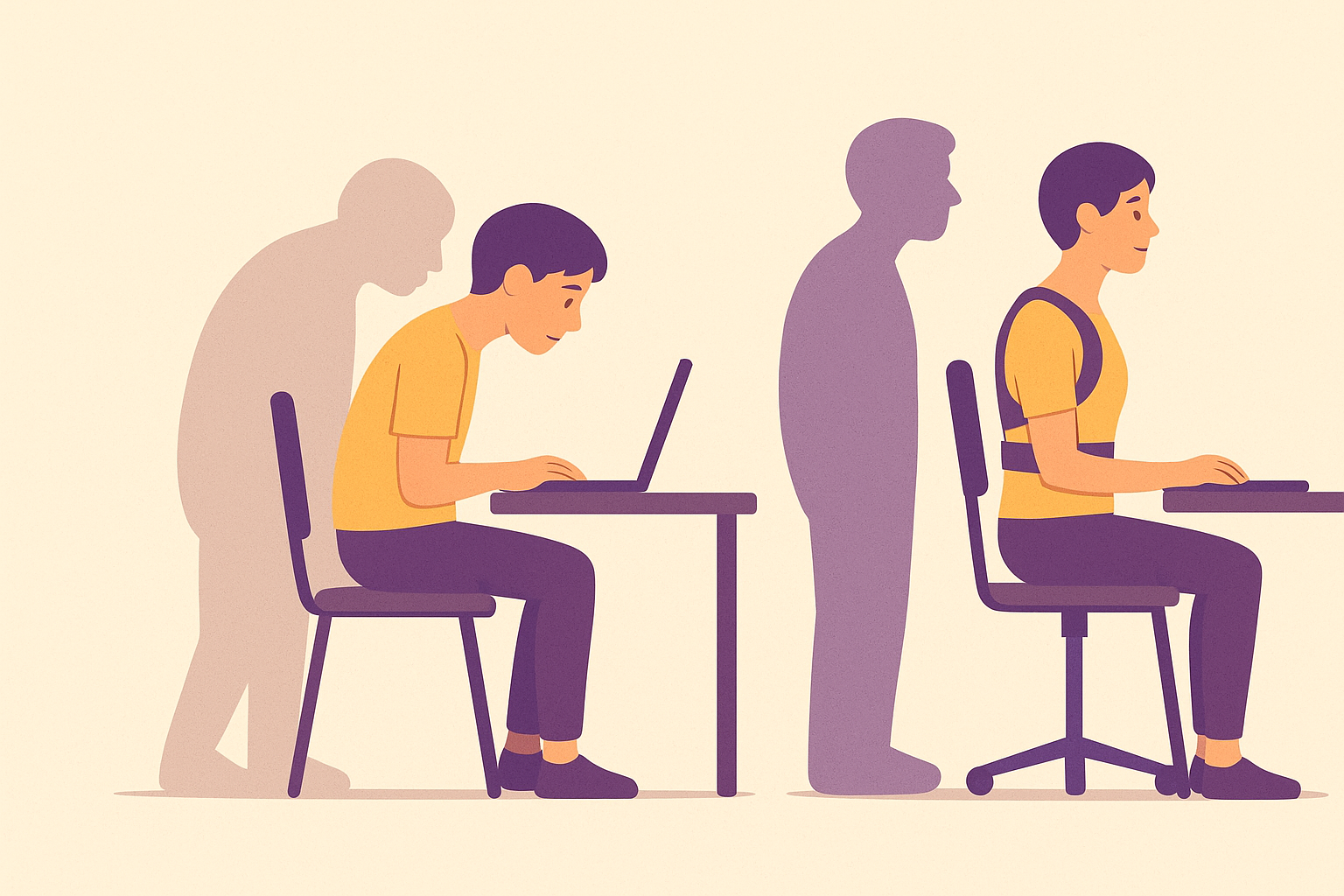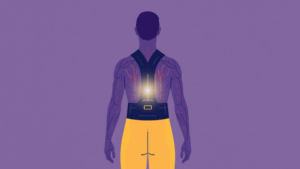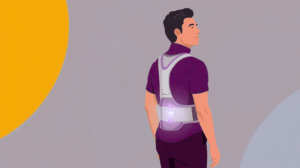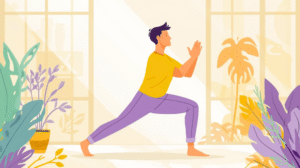Imagine, one morning, you catch your reflection in the mirror, and something feels off. It’s not the dark circles from late-night scrolling or the coffee stains on your shirt. It’s the way your shoulders slump forward, your neck cranes down, and your spine looks like it’s silently screaming for a chiropractor. You don’t look tired ; you look older.
Here’s the uncomfortable truth: your posture isn’t just about avoiding back pain; it’s about how you carry your age, both physically and emotionally. And the scary part? You might be “aging” your body years faster than your actual birthday candles.
The good news? There’s help, and it doesn’t come in the form of a pill, cream, or expensive massage package. A posture correction belt. Yes, that simple strap combined with lifestyle tweaks like ergonomics cushions and movement breaks , might be your secret weapon against premature posture aging and remind your body to stand tall again.
This isn’t a story about vanity. It’s about energy, confidence, and slowing down the hidden ways bad posture chips away at your health. Let’s walk through the sneaky journey of slouching, why it ages you, and how awareness (plus the right tools like posture corrector belts) can reverse it before your back feels decades older than you.
How Did Sitting Wrong Become ‘Normal’ (and Why Your Back Pain Proves It’s Not)?
From Classroom Benches to Office Chairs:-
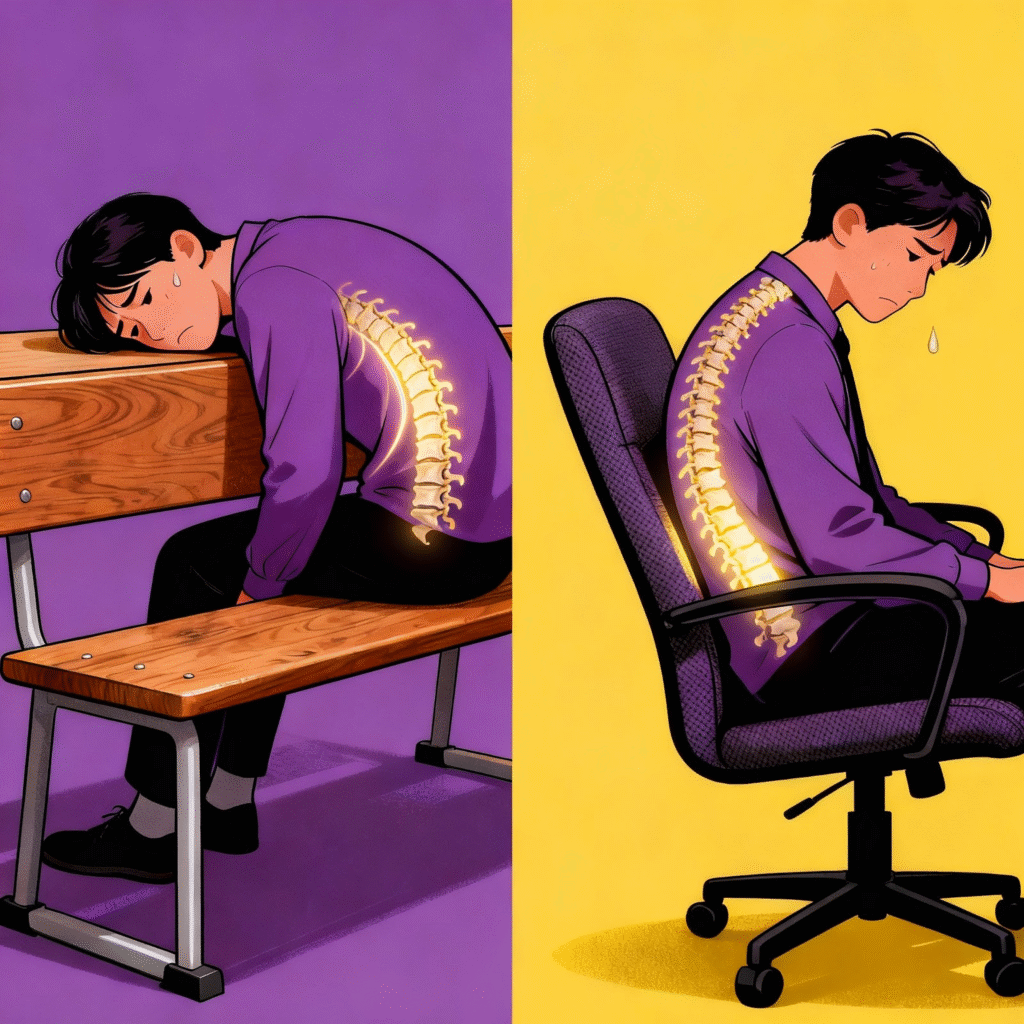
Think back to school days: the hard wooden benches, endless lectures, and the casual forward slump that became second nature. Fast forward to college library marathons and now office chairs designed more for style than spine alignment. Your posture didn’t suddenly “go bad.” It was slowly trained into you, seat by seat.
Just like handwriting habits, posture is learned. The problem? While no one ever scolded you for slouching, your spine definitely keeps the receipts.
Why Does Your Body “Learn” Bad Posture Like a Bad Habit?
Posture isn’t just a position; it’s muscle memory. When you slouch every day, your muscles adapt to make slouching feel “normal.” Over time, your postural muscles weaken, and your stabilizers stop working as intended. The result: your body thinks hunching is the default mode.
Here’s the kicker: correcting bad posture later in life feels uncomfortable, not because standing tall is wrong, but because you’ve trained your body to believe slouching is right. And that’s how small habits in classrooms and offices echo into adulthood, setting the stage for long-term effects of poor posture like back pain, fatigue, and even premature aging [1].
How Bad Posture Secretly Destroys Confidence in Public?
The Confidence Illusion
You walk into a meeting room. Two people stand before you. One is upright, shoulders back, head steady. The other is slouched, gaze downward. Without a word, your brain decides who’s more confident, more trustworthy. And guess what? The science agrees; upright posture is linked with posture correction and confidence, projecting authority and self-assurance [2].
Unfortunately, most of us underestimate how much slouching chips away at our image. You might feel prepared, but if your body language says otherwise, people will believe the slump.
The Photo Test
Ever scrolled through group photos and groaned at the one where you look hunched and older than your age? That’s posture at play. Bad posture doesn’t just make you look tired, it can literally make you look years older [3], and unlike a bad hairstyle, this isn’t a one-day mistake. It’s a pattern that gets recorded in every candid shot.
In today’s camera-ready culture, where a casual selfie can live online forever, the way you carry yourself visually writes your “confidence résumé.” The question is :- what story is your spine telling?
Does Bad Posture Secretly Drain Your Energy Every Day?
Why Bad Posture Makes Breathing Harder?
Here’s something most people miss: when you slump forward, your lungs don’t expand fully. This restricts oxygen intake, meaning your body literally runs on less fuel. Less oxygen = more fatigue, shallow breathing, and reduced endurance [4].
Brain Fog and the Afternoon Crash
Ever wonder why the 3 p.m. slump hits so hard? Poor posture plays a sneaky role. Reduced oxygen circulation doesn’t just sap your muscles, it clouds your brain. Research shows slouching can lead to reduced alertness and concentration [5].
Translation: your spine could be hijacking your productivity. That “afternoon crash” might not be your diet, it could be your chair and the way you sit in it.
What If Slouching Is Making Your Joints and Hormones Act Older Than You Are ?
Joints That Feel Decades Older
When your posture is off, stress doesn’t distribute evenly across joints. Over time, this leads to uneven wear, like tires going bald on one side. Conditions like arthritis can worsen with bad posture, leaving joints stiffer and more painful than they should be at your age [6].
Stress, Mood, and Hormone Rollercoaster
It’s not just bones and muscles, slouching affects your nervous system. Poor posture increases cortisol (the stress hormone) and reduces testosterone, a combo that leaves you feeling drained, anxious, and yes, older [7].
Your spine alignment isn’t just mechanical, it’s hormonal, emotional, and deeply tied to how you age from the inside out.
Benefits of a Posture Corrector Belt
More Coach, Less Corset
Forget the scary images of Victorian corsets. A modern posture corrector belt isn’t about forcing your body into submission. Think of it more like a coach gently tapping you on the shoulder when you slouch. It doesn’t do the work for you, it reminds your muscles to step up.
Small Daily Wins That Add Up
Worn for short periods during the day, the belt retrains your muscle memory, helping you naturally maintain upright posture over time. Pair it with stretching and ergonomic tweaks, and you’re setting yourself up for long-term gains in spine health. Many people report reduced back pain and increased energy just from consistent use [8].
What It Won’t Do (and That’s a Good Thing)?
It’s not a magic cure. Over-relying on it can weaken your muscles. The key is balance: use the belt as a training tool, not a crutch. The best posture corrector belt for daily use should be lightweight, adjustable, and something you forget you’re wearing, until you slouch, and it reminds you to rise again.
What If Poor Posture Is Quietly Stealing Your Height?
How Spinal Compression Makes You Appear Shorter?
Long-term slouching compresses spinal discs, shaving off precious inches. While it may not sound dramatic, the psychological impact of feeling “shorter” often gets linked with aging [9].
Standing Tall as a Visual Age Rewind
Here’s the fun part: corrected posture can instantly add visible inches back, like a no-cost makeover. A posture corrector belt acts as a daily reminder to stretch up, creating the illusion of a taller, more youthful version of yourself.
Is Sitting Wrong Making Your Face Look Older Too?
Forward Head = Neck Wrinkles and Jaw Tension
That dreaded “tech neck”? It’s not just uncomfortable, it carves permanent lines into your skin. Slouching creates unnatural folds in the neck and adds strain that accelerates facial sagging [10].
How Upright Posture Improves Facial Appearance?
Better posture means better circulation. With your chest open and head upright, blood and oxygen flow freely, keeping skin vibrant. In a world obsessed with anti-aging creams, this is the cheapest glow-up hack around.
Could Fixing Your Posture Be the Cheapest Anti-Aging Hack Ever?
Why Posture Is More Powerful Than Creams or Supplements?
Think about it, people spend fortunes on skincare, supplements, and cosmetic fixes, but ignore the free upgrade sitting right under their shoulders, the posture. Standing tall delivers energy, confidence, and a natural glow that no bottle can replicate.
The Belt as Your Everyday Reminder
A posture corrector belt becomes the simplest, most practical reminder to practice this “anti-aging hack” daily. No appointments, no chemical side effects, just awareness strapped comfortably around your shoulders.
What If Posture Awareness Was a Social Movement?
Workplaces That Normalize Straight Sitting
Imagine offices offering posture breaks the same way they encourage coffee breaks. With ergonomics and posture training, we’d see fewer sick days, healthier teams, and maybe even happier Monday mornings. A culture that celebrates straight sitting could boost productivity while reminding employees that wellness isn’t a luxury, it’s part of the job.
Schools Teaching Kids to “Wear Their Spine Proud”
What if schools taught posture alongside math? Children would grow up preventing posture and premature aging instead of trying to undo years of slouching. By planting these habits early, we’d be raising a generation that stands taller; both physically and in confidence.
Conclusion: Your Posture Is Your Future Self !
Posture isn’t just about avoiding a sore back, it’s about how you age, how you feel, and how the world sees you. Every slouch takes tiny withdrawals from your energy, confidence, and youthfulness. Every upright stance makes a deposit toward a healthier, more vibrant future.
A posture corrector belt won’t magically solve everything, but it can be the spark that reminds you: your body was built to stand tall. Pair it with natural strengthening, ergonomic tweaks, and a little awareness, and you’ll notice something remarkable, the day your back stops feeling older than you.
Because in the end, posture is less about vanity and more about vitality. And your spine deserves to carry you proudly, not quietly wear you down.
Frequently Asked Questions
1. Does bad posture make you look older?
Yes. Slouching creates physical signs like wrinkles, hunched shoulders, and shorter height that mimic aging [11].
2. Can a posture corrector belt really fix back pain?
It helps by retraining muscles and reducing strain, but pairing it with stretching and ergonomic changes is essential.
3. What are the long-term effects of poor posture?
Joint pain, spinal degeneration, shallow breathing, fatigue, and increased risk of lifestyle diseases.
4. What is the best posture corrector belt for daily use?
One that is adjustable, lightweight, and breathable, designed for short daily wear.
5. What are posture belt benefits vs risks?
Benefits: awareness, retraining muscles, reducing discomfort. Risks: overdependence if worn too long without exercise.
6. How to improve posture naturally?
Strengthening postural muscles, mindful breaks, ergonomic solutions for better posture, yoga, and gentle reminders like a belt.
Explore More Health & Wellness Solutions
Want to stay informed about wellness and everyday health issues? Here are some insightful reads to guide you. Explore the links below for practical tips and solutions:-
- https://betterhood.in/learn/neck-support-for-elderly/
- https://betterhood.in/learn/posture-problems-in-the-real-world/
- https://betterhood.in/learn/the-comfort-trap-shocking-link-between-cushioned-soles-and-back-pain/
- https://betterhood.in/learn/science-of-vibration-and-back-pain-in-vehicles/
References:
- Lafond, D., Maher, C., & Holmes, M. W. (2007). Postural development in school children: a cross-sectional study. BMC Pediatrics, 7, Article 14. What it shows: Childhood/postural habits relate to back pain in adolescence, which is a risk factor for adult pain. Link
- Körner, R., Röseler, L., Schütz, A., & Bushman, B. J. (2022). Dominance and prestige: Meta-analytic review of experimentally induced body position effects on behavioral, self-report, and physiological variables. Psychological Bulletin, 148(3), 293-328. Link
- Huang, T., Hsiao, J., & Chien-Yuan Chen, C.-Y. (2013). Attractiveness is Influenced by the Relationship between Postures of the Viewer and the Viewed Person. i-Perception, 4(7),Link
- Kang, K. W., Kim, J., Chang, M. H., Lee, E. J., & Lee, J. (2016). Effect of sitting posture on respiratory function while using a smartphone. Journal of Physical Therapy Science, 28(11), 3037-3040.Link
- Caldwell, J. A., Prazinko, B., & Caldwell, J. L. (2003). Body posture affects electroencephalographic activity and psychomotor vigilance performance in sleep-deprived subjects. Clinical Neurophysiology, 114(1), 23-31. https://doi.org/10.1016/S1388-2457(02)00335-9 Link
- Fu, P., Xu, W., Pingcheng Xu, Huang, J., & Guo, J. J. (2023). Relationship between spinal imbalance and knee osteoarthritis by using full-body EOS. BMC Musculoskeletal Disorders, 24, Article 402. https://doi.org/10.1186/s12891-023-06508-5 Link
- Carney, D. R., Cuddy, A. J. C., & Yap, A. J. (2010). Power posing: Brief nonverbal displays affect neuroendocrine levels and risk tolerance. Psychological Science, 21(10), 1363–1368. https://doi.org/10.1177/0956797610383437 Link
- Mokhtarinia, H., Ghamary, J., Maleki-Ghahfarokhi, A., Asgari, M., Gabel, C. P., & Parnianpour, M. (2019). The new “Tehran Back Belt”: design then testing during a simulated sitting task improved biomechanical spine muscle activity. Health Promotion Perspectives, 9(2), 115-122. Link
- Magnusson, M. L., Pope, M. H., Wilder, D. G., Spratt, K., Szpalski, M., & Nordin, M. (1996). Changes in spinal height following sustained lumbar flexion and extension postures: a clinical measure of intervertebral disc hydration using stadiometry. Journal of Manipulative & Physiological Therapeutics, 19(9), 576-580. https://doi.org/10.1016/S0161-4754(96)80034-4 Link
- A case series showed that horizontal neck wrinkles develop with age and skin changes (loss of elasticity, thinning, etc.), and treatments like hyaluronic acid plus thread-lifting can improve them. But this doesn’t prove that posture alone “carves” permanent lines or causes sagging due to bad posture. Link
- A Harvard Health article noting that slouching posture is commonly associated with appearing smaller or more stooped with age, and that posture worsens with age, contributing to spinal compression and visible changes. Link
